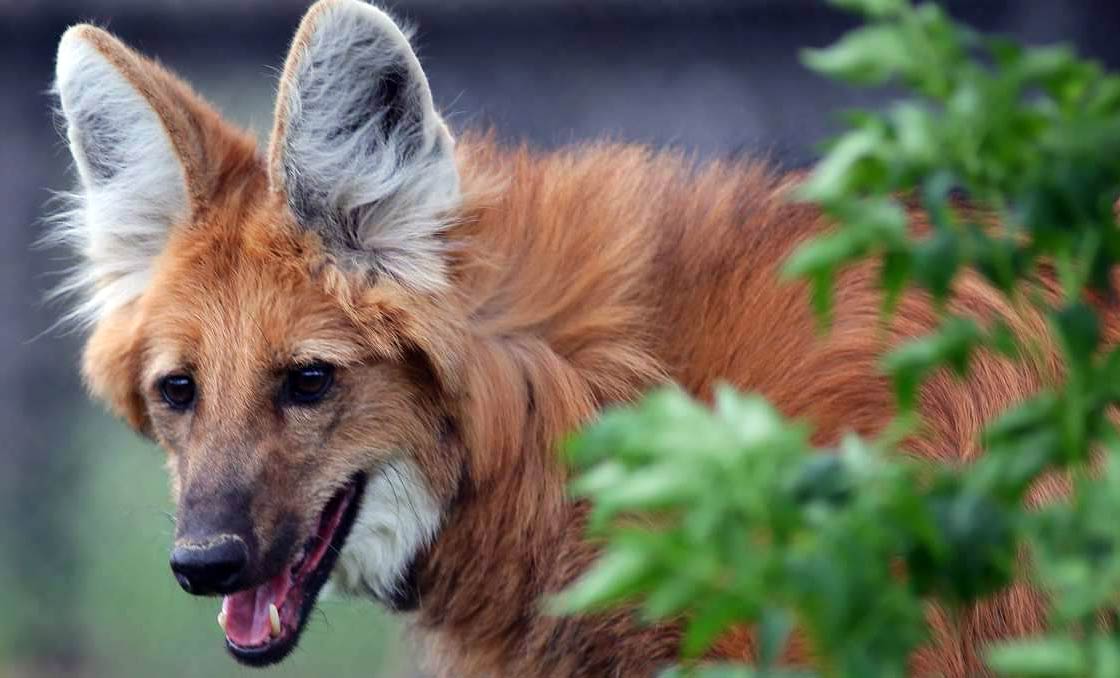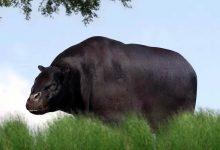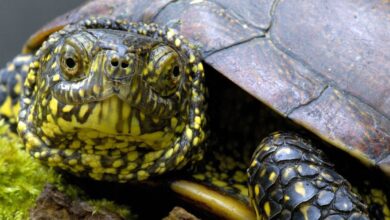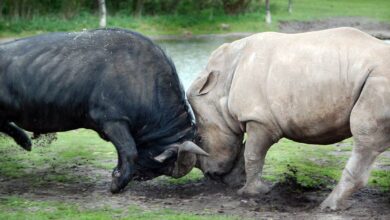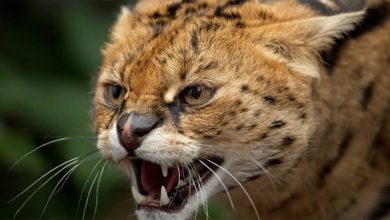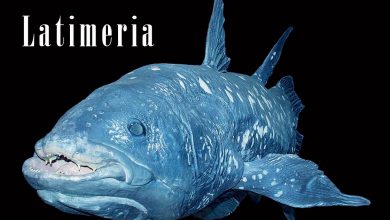Maned wolf (Chrysocyon brachyurus) – “golden dog”
South American peoples call it aguará guazú, kalak, lobo de crin, lobo de los esteros, lobo-guará, borochi or lobo colorado. It is sometimes called a skunk wolf (“smelly wolf”). How did the maned wolf deserve that last, infamous name? What else, apart from the ginger hair and black mane, is different from the rest of the wolf species? Let’s meet the tallest wild canine in the world who chose South America as its home.
Classification
- Kingdom: Animalia
- Phylum: Chordata
- Class: Mammalia
- Order: Carnivora
- Family: Canidae
- Subfamily: Caninae
- Tribe: Canini
- Genus: Chrysocyon
- Species: Chrysocyon brachyurus

Dog or not a dog?
Maned wolf is not closely related to any of the canines living today. It is the only representative of the genus Chrysocyon. Based on morphological similarities, it was previously placed in the genera Vulpes (foxes) and Canis (jackals, coyotes, wolves and dogs).
The closest living relative of the maned wolf is the bush dog (Speothos venaticus) we have already described. However, it is difficult to see the similarity at first glance – they look together like a Great Dane with a dachshund 🙂
It has little in common with other South American canines, such as the short-eared dog (Atelocynus microtis), the majkong, crab-eating fox (Cerdocyon thous) or the South American foxes of the genus (Lycalopex).

Occurrence
This long-legged fox-like mammal is found in central South America – including northeastern Brazil, Paraguay and Peru. It is also found in some areas of Bolivia and Argentina, and possibly also in Uruguay, although it is believed that the species died out there in the 19th century.
Habitats
The maned wolf lives in a variety of habitats, from meadows overgrown with tall grasses, through forest edges, to marshy areas. In Brazil, he chose the cerrado for his habitat – an ecoregion rich in savannas and plateaus.

Characteristic
Appearance
Despite its resemblance to a fox, the maned wolf is most closely related to the mammals of the genus Canis. It is covered with beautiful, long, golden-red hair, there are large, protruding ears on the head, and the muzzle is narrow and long. A similar description certainly fits the red fox (Vulpes vulpes). However, it is distinguished from the European fox by very long and slim limbs. Thanks to them, the animal can observe its surroundings while walking in tall grasses. The fox is therefore much shorter than the maned wolf.
It is assumed that the long legs of the maned wolf are an adaptation to the tall grass in which it lives, not to high speed as is the case of the cheetah.
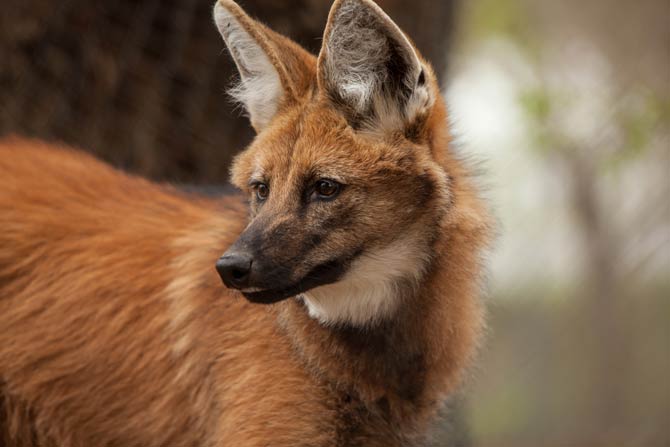
Mane
The species name refers to the characteristic black mane that extends from the nape of the neck to the shoulder blades. When a predator is excited or senses a threat, it rises its mane, becoming visually larger. Another way to deter an intruder is by the smell that the mammal emits to mark territory. For this reason, the maned wolf is sometimes called the “stinking wolf”.
The muzzle (snout) and the lower limbs, similar to the mane, are black in color. The inside of the ears, throat and tip of the tail are white.
Size
The average maned wolf measures a maximum of 90-100 cm (35 – 39 in) at the withers, approx. 100 cm (39 in) long (excluding the tail) and weighs approx. 20 kg (44 lb). Therefore, it has a very light and delicate structure.
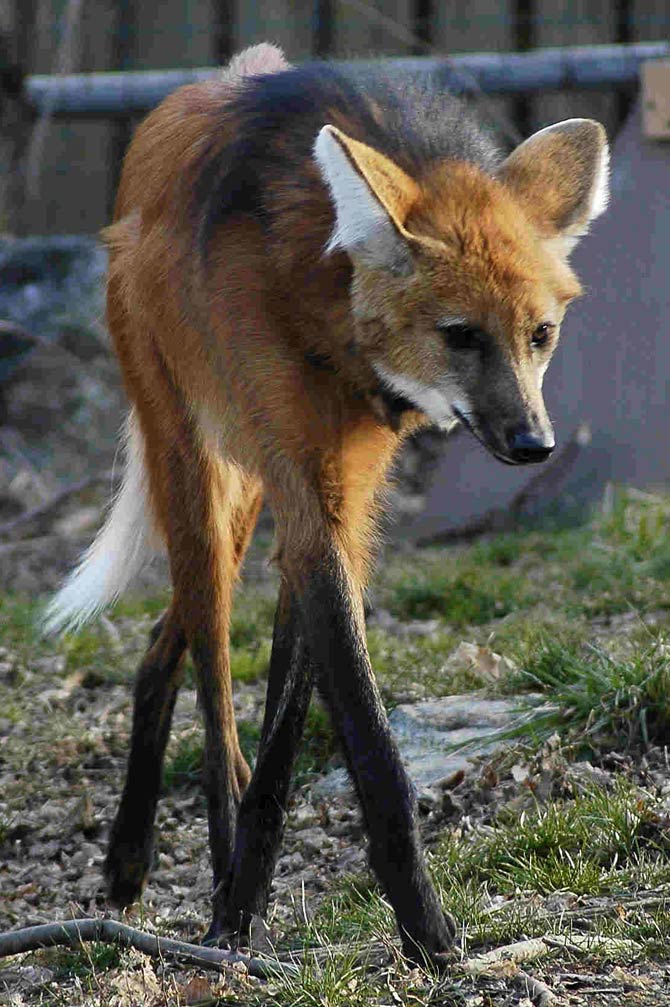
Diet
Despite the close relationship with predatory canids, the maned wolf eats fruit willingly. The main source of food is the fruit of the Solanum lycocarpum tree, known as wolf apples. Apart from them, of course, it eats other animals, including rabbits, armadillos, sometimes Pampas deers (Ozotoceros bezoarticus), as well as birds, fish, reptiles, insects and arthropods. It also does not avoid carcasses, he also sometimes kidnaps hens from farms. It hunts mainly at night, but it also does it at dusk or at dawn, while other animals are still sleeping in the thick grass.
Vegetables and fruit can make up 50% of the maned wolf’s diet.
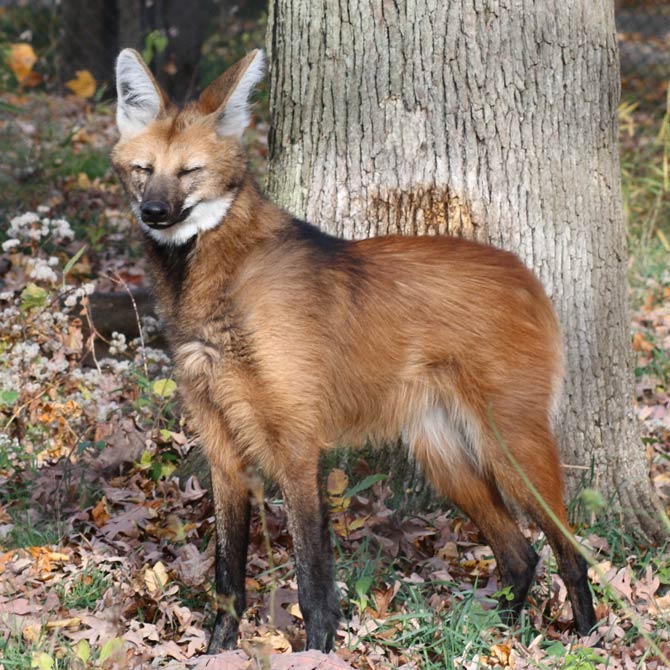
Hunting methods and territoriality
A loner by choice
Not only the maned wolf’s menu clearly distinguishes it from other wolf species. This predator also does not create herds (packs) in which each member has a different function to fulfill. He predominantly leads a solitary lifestyle. It can only mate for short periods with a partner of the opposite sex only during the breeding season.
During the year, despite the interpenetrating territories, males and females live independently of each other. Strangers can meet at an abundant source of food, for example, during farm fires, when rodents and other small vertebrates are massively fleeing from fire-threatened areas.
Both males and females communicate with each other using scent markings such as urine. They leave these traces on hunting trails or in places where they have buried their prey. The smell of maned wolf urine is very characteristic – many associate it with hops or hemp. The component (pyrazine) is responsible for it, which is present both in the urine of the animal and in the plants mentioned.
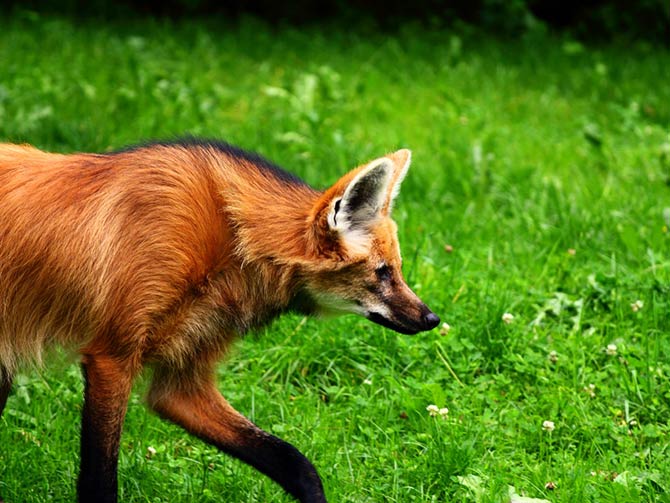
Reproduction
It drowns out his solitary aspirations between April and June, when the breeding season is on. Females give birth to 1-5 puppies each year – births take place mainly between June and September. Gestation lasts 60-65 days.
Previously, it was believed that only the mother was responsible for the care of the young. However, observations of these animals in captivity showed that the father also takes care of raising, feeding and cleaning his offspring.
Puppies become fully mature after they are around 1 year old. Usually, however, they start reproducing after about 2 years.
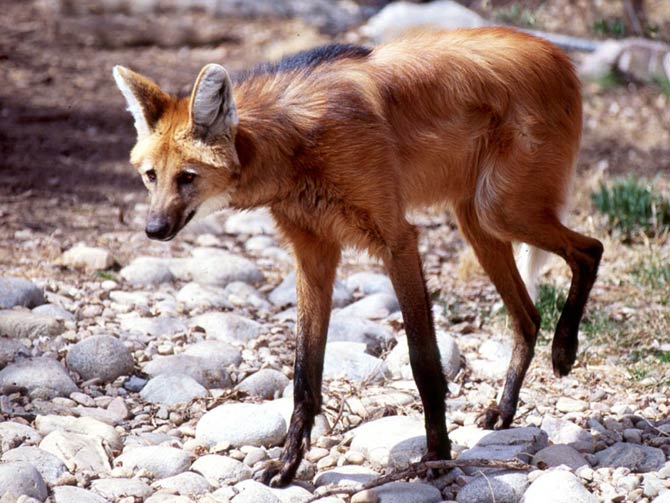
Maned wolf and man
It does not pose a threat to human life, because it is shy and runs away when it feels anxious. However, it is considered a chicken thief and in the past a killer of cattle and sheep.
In the past, in several regions of Brazil, these animals were killed for a few body parts, mainly the eyes considered an amulet to attract good luck. However, following the reclassification of the species as endangered, the Brazilian government condemns poaching and introduced new rules to protect the species.
The main threats to the species survival are habitat loss as well as death under the wheels of vehicles. Diseases transmitted by feral and domestic dogs, which often attack maned wolves, are also a big problem.

Detailed data / dimensions (size)
Maned wolf (Chrysocyon brachyurus)
- Body length without tail: 100 cm (39 in)
- The length of the tail: 45 cm (18 in)
- Height at the withers: 74-90 cm (29 – 35 in)
- Weight: average 23 kg (51 lb)
- Lifespan: up to 16 years in captivity
- Speed: max. 76 km/h (47 mph)
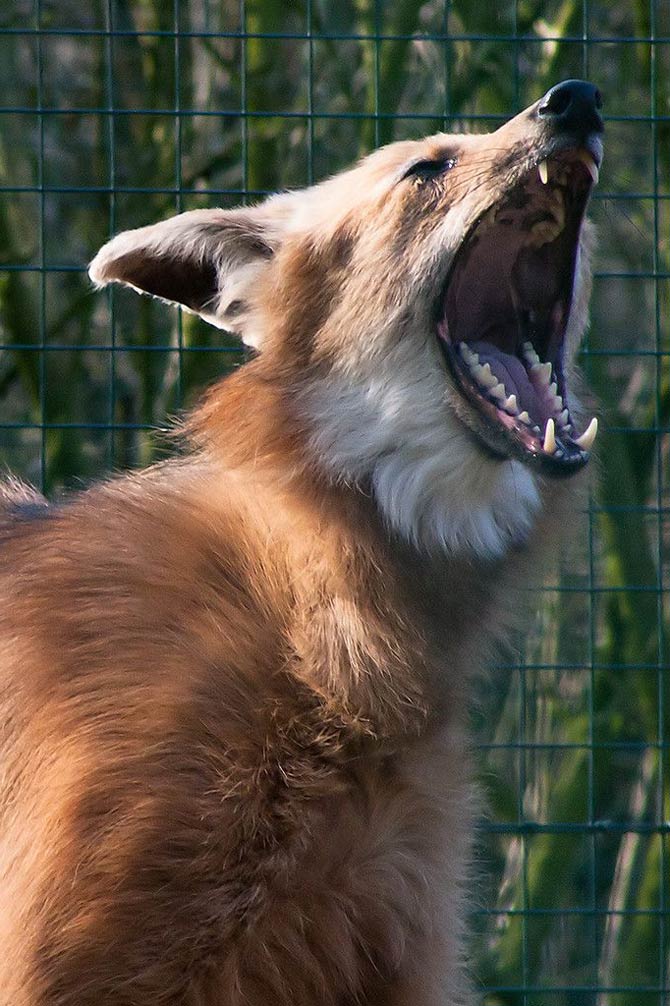
Maned wolf – interesting facts
- Maned wolf, as the only South American canine species, survived the Quaternary extinction. Fossils of the maned wolf ancestors date back to the Late Pleistocene and the Holocene.
- Maned wolf is the largest representative of canids in South America and the only representative of the genus Chrysocyon.
- The maned wolf is the tallest wild canid.
- Vegetables and fruits can make up 50% of the maned wolf’s diet, including sugar cane, tubers, and fruit.
- The smell of maned wolf urine is so strong that in the Rotterdam ZOO, the police, confused by it, searched for marijuana smokers.
- Maned wolf breeds well in captivity. It is successfully bred in many zoos, mainly in Argentina.
- Maned wolves move in an ambling gait (they simultaneously lift the limbs of one side of the body – for example, the right front and right back, and then the left front and left back). A similar gait can be observed in camels, giraffes and some breeds of dogs – such as the Czechoslovakian Wolfdog.
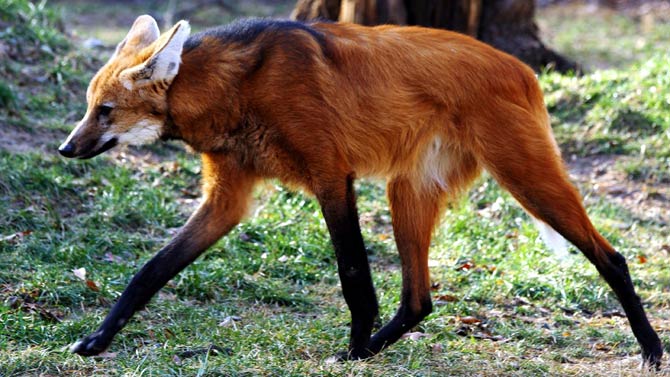
Recommended
- Asian golden cat
- Lion vs tiger
- Tsavo lions
- Barbary lion
- Siberian tiger
- Bengal tiger
- Sumatran tiger
- Indochinese tiger
- Malayan tiger
- Tigers
- White tigers
- Lions
- White lions
- Liger
- Animal fights
- American lion
- European cave lion
- Smilodon – Saber-toothed tiger
- Big cats
- Black panther
- Leopard
- Snow leopard
- African Lion
- Fastest animals
- Fastest birds

